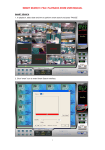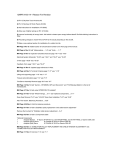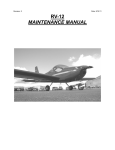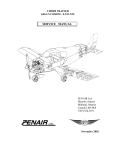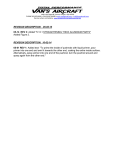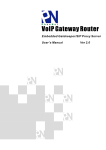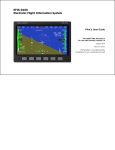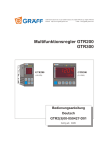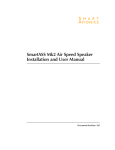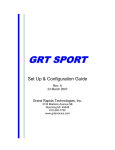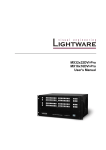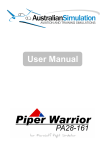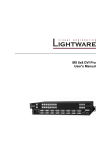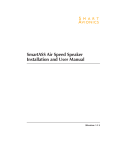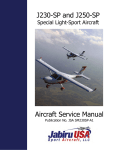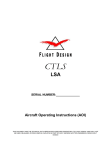Download FTS - Van`s Aircraft, Inc.
Transcript
12NPR 04-03-14-1 Reason For Revision 1) RV-12 SkyView Touch Avionics Kit 2) RV-12 SkyView AP-Knob Panels Kit (58) 3) Add instructions for installation of F-00062. 4) Allow use of lighter springs on RV-12 throttle 5) Improve functionality of canopy latch. Add switch to detect open canopy before takeoff. Re-Write ditching instructions in POH. 6) Placarding changes to match KAI and POH to the actual placarding on the aircraft. 7) Make a new optional section for installation of a rudder trim tab. FTS Page 04-01 Rev 2: Update index FTS Page 04-04 Rev 2: Show new version of rudder gust lock. “…then stow in map box.” s.b. “…then stow in baggage area.” FTS Page 04-05 Rev 2: Add a new page to describe function of Canopy Closed Safety Switch. Repaginate remainder of the section. FTS Page 04-15 Rev 2: “Verify that the rudder hinge bolt is installed.” was “Verify that the rudder upper hinge bolt is installed.” FTS Page 05-12 Rev 2: Add information on the new throttle springs and vernier style throttle. Repaginate remainder of the section. Move contents of this page to Page 5-13. Add text for new springs using a lower lb/in spring rate. Add text for new vernier style throttle. FTS Page 05-13 Rev 2: Move contents of this page to Page 5-14. Move contents of Page 5-12 to this page. FTS Page 05-14 Rev 2: Remove “THIS PAGE INTENTIONALY LEFT BLANK” Move contents of Page 5-13 to this page. FTS Page 06-01 Rev 2: Under “GENERAL” add to the reference list of avionics G3X, SkyView, GTR200 and GPS MAP. “Do not attempt to learn the basics of these systems while flying the aircraft.” Was “Do not attempt to learn the basics of these systems in the aircraft.” FTS Page 06-05 Rev 2: In the figure at the top of the page “SKYVIEW DISPLAY” was “OVERFLOW VENT” FTS Page 06-06 Rev 2: Under Autopilot switch “…autopilot and SV-AP-PANEL (if installed).” was “…autopilot (if installed).” FTS Page 06-07 Rev 2: Add a new Page for G3X. Repaginate the rest of the section. FTS Page 06-08 Rev 2: Add a new Page for G3X. Repaginate the rest of the section. FTS Page 06-10 Rev 2: Add depiction of fuse holder mounted under panel for dual screen installation. FTS Page 07-01 Rev 1: under choke “Pull detent switch ON” should be Choke Cold Start “PULL tee handle fully out and hold. Crank engine. When engine starts move control to half way position and rotate 90o- clockwise to lock.“ was “PULL tee handle fully out (apporx 1 inch) and rotate 90o clockwise to lock” After choke off remove cold start information as it is redundant. “Throttle / Choke – 2500 rpm max” was “Throttle – 2500 rpm max” Make remainder of this page match the FTS FTS Page 07-02 Rev 1: “Brakes – HOLD” was “Brakes – SET” Minimum Oil Temp “122° F” was “120° F” Add to Seatbelt… “…& SNUG” Taxi rpm “1800…” was “1400…” Under ignition “(max diff – 115)” was “(max diff – 120)” This changed per latest Rotax operating manual. FTS Page 08-01 Rev 2: “…raise the nose just clear of the ground as early in the take-off roll as possible with the elevator control to improve rudder authority and prevent drifting or premature lift-off.” was “…raise the nose to a lower than normal attitude with the elevator control to prevent drifting or premature lift-off.” Update index FTS Page 09-01 Rev 2: “5800 rpm Max 5 min” was “MAX rpm Max 5 min” FTS Page 14-01 Rev 1: Before “The EFIS and GPS..” add “SkyView Only:” Make FTS match POH FTS Page 15-01 Rev 2: Make FTS match POH FTS Page 15-02 Rev 2: Under “GENERATOR/ELECTRICAL FAILURE” “Turn OFF all non-essential electrical…will continue on the backup battery.” Was “Turn OFF all non-essential electrical…will continue to operate on their internal batteries.” Make FTS match POH FTS Page 15-03 Rev 2: “NOTE (SkyView Only) Zero oil…” was “NOTE Zero oil…” Make FTS match POH FTS Page 15-04 Rev 2: Make FTS match POH FTS Page 15-05 Rev 2: Make FTS match POH Under “DITCHING” move “Canopy – UNLATCH” from the first step to the step just before contact. FTS Page 15-06 Rev 2: Add “Move the Autopilot switch position to OFF” just after “Pull the trim fuse…” under “RUNAWAY TRIM MOTOR” Make FTS match POH FTS: Revision Levels Changed: SECTION COVER PAGE 1 2 3 4 5 6 7 8 9 10 11 12 REVISION 2 1 1 0 2 2 2 1 2 2 0 0 0 DATE 04/03/14 07/09/09 07/09/09 07/09/09 04/03/14 04/03/14 04/03/14 04/03/14 04/03/14 04/03/14 07/09/09 07/09/09 07/09/09 13 14 15 16 FRONT COVER REAR COVER 1 1 2 0 2 2 08/12/13 04/03/14 04/03/14 07/09/09 04/03/14 04/03/14 Revision: 2 Date: 04/03/14 RV-12 FLIGHT TRAINING SUPPLEMENT RV-12 Flight Training Supplement i Date: 04/03/14 Revision: 2 REVISION SUMMARY SECTION COVER PAGE 1 2 3 4 5 6 7 8 9 10 11 12 13 14 15 16 FRONT COVER REAR COVER ii REVISION 2 1 1 0 2 2 2 1 2 2 0 0 0 1 1 2 0 2 2 DATE 04/03/14 07/09/09 07/09/09 07/09/09 04/03/14 04/03/14 04/03/14 04/03/14 04/03/14 04/03/14 07/09/09 07/09/09 07/09/09 08/12/13 04/03/14 04/03/14 07/09/09 04/03/14 04/03/14 RV-12 Flight Training Supplement Revision: 2 Date: 04/03/14 TABLE OF CONTENTS COVER PAGE i REVISION SUMMARY ii TABLE OF CONTENTS iii SECT I INTRODUCTION 1-1 SECT II AIRCRAFT DESCRIPTION 2-1 SECT III PRE-FLIGHT PLANNING 3-1 SECT IV PRE-FLIGHT INSPECTION 4-1 SECT V CABIN OVERVIEW 5-1 SECT VI INSTRUMENTATION, AVIONICS, & ELECTRICAL SYSTEM 6-1 PRE-TAKEOFF GROUND OPERATIONS 7-1 SECT VIII TAKE-OFF 8-1 SECT IX CLIMB 9-1 SECT X CRUISE 10-1 SECT XI MANEUVERING FLIGHT 11-1 SECT XII DESCENT 12-1 SECT XIII LANDING 13-1 SECT XIV SHUT DOWN 14-1 SECT XV EMERGENCY PROCEDURES 15-1 SECT XVI GROUND HANDLING 16-1 SECT VII RV-12 Flight Training Supplement iii Date: 04/03/14 Revision: 2 THIS PAGE INTENTIONALLY LEFT BLANK iv RV-12 Flight Training Supplement Revision: 1 Date: 07/09/09 SECTION I INTRODUCTION INDEX PURPOSE OF THIS MANUAL RECOMMENDED READING RECOMMENDED LINKS 1-1 1-1 1-3 Purpose of this Manual This Flight Training Supplement (FTS) was carefully prepared by the test pilots, flight instructors, and engineers of Van's Aircraft - the manufacturer of the RV-12. The FTS has been prepared with the goal of enabling the new pilot or pilot transitioning from another aircraft to quickly and efficiently learn about features and characteristics specific to the RV-12. This FTS is provided to supplement the information provided in the Pilots Operating Handbook (POH) but does not replace it. Some sections of the POH are mirrored in this manual but this manual provides expanded, more detailed, and in-depth information than is practical to include in the POH. It is, therefore, strongly recommended that the pilot be familiar with this Flight Training Supplement, the Pilots Operating Handbook, and the aircraft prior to flight. Definitions The words “WARNING”, “CAUTION”, and “NOTE” are used throughout the manual with the following definitions: WARNING An operating procedure, practice, or condition, etc. which may result in injury or fatality if not carefully observed or followed. CAUTION An operating procedure, practice, or condition, etc. which if not strictly observed may damage the aircraft or equipment. NOTE An operating procedure, practice, or condition, etc. Recommended Reading 1. Pilot's Operating Handbook for RV-12 2. Aircraft Maintenance and Inspection Procedures for RV-12 3. User Manuals of components and accessories RV-12 Flight Training Supplement 1-1 Date: 07/09/09 Recommended Links Revision: 1 1. General information about Van's Aircraft as well as drawing and manual revisions: http://vansaircraft.com/ 2. General information about the Sport Pilot rule and Light Sport Aircraft: http://sportpilot.org/ 3. ACK ELT: http://ackavionics.com 4. Artex ME406 User's Manual: http://acrartex.com 5. Dynon Avionics: http://dynonavionics.com/ 6. Flightcom FC-403 User's Manual: http://flightcom.net/ 7. Garmin Avionics: https://buy.garmin.com/ 8. Information about Matco wheels and brakes: http://matcomfg.com/ 9. PS Engineering: http://ps-engineering.com 10. Rotax Owner Assistance Network: http://rotax-owner.com/ 1-2 RV-12 Flight Training Supplement Revision: 1 Date: 07/09/09 SECTION II AIRCRAFT DESCRIPTION INDEX LIGHT SPORT AIRCRAFT OVERVIEW RV-12 DESIGN PHILOSOPY 2-1 2-1 LIGHT SPORT AIRCRAFT OVERVIEW A NEW AVIATION HORIZON: In 2004, the FAA created sport pilot/light-sport aircraft (SP/LSA) regulations. The most significant change in FAA regulations in 50 years, it allows easier and lower-cost access for those wishing to participate in the joy of flight. With adoption of SP/LSA, flying has become less expensive and easier than ever before. You can become a sport pilot with as little as 20 hours of flight instruction. You can fly a one- or two-seat aircraft capable of speeds up to 120 kt (138 mph). And in most cases, you can pass the medical requirements just by showing your driver's license. BASIC PARAMETERS OF LSA: The FAA has defined light-sport aircraft as simple-to-operate, easy-to-fly aircraft that, since initial certification, has continued to meet the following performance definition: Maximum gross weight of 1,320 lb Maximum cruise configuration stall speed of 45 kt CAS Maximum speed in level flight with maximum continuous power of 120 kt CAS One or two person occupancy (pilot and one passenger) Fixed or ground adjustable propeller Fixed landing gear Single reciprocating engine Unpressurized cabin Light Sport Aircraft may seem familiar to us by their appearance, but they are in fact quite different from the traditional aircraft we are used to. First, LSAs weigh significantly less than many aircraft. With a typical empty weight of 750 lb and a take-off weight of not more than 1320 lb, they are indeed light aircraft. The light weight, coupled with a generous wing area means that they have a low wing loading thus making them more susceptible to wind currents than larger, high wing loading aircraft. A good pilot needs, therefore, to remain vigilant from the time the aircraft first moves under its own power until after the landing is complete and the aircraft is brought to a full stop. Pilots who may have experience with traditional aircraft but are new to LSAs need to approach LSAs with an open mind. Open to the fact that a Light Sport Aircraft is different than a traditional aircraft and open to the reality that pilots can, over time, develop flying habits that are flat-out wrong or at least inappropriate to an aircraft with the weight, power loading, and wing loading of an LSA. RV-12 DESIGN PHILOSOPHY INTRODUCTION: Let's take a look at the design philosophy and goals that are the basis for this airplane. The goal was to achieve the maximum overall performance, flying enjoyment, ease of construction, building and flying economy, ease of maintenance, and pleasing appearance possible for a two-place airplane. Understanding how this was achieved might help you better appreciate many features of the RV-12 as you encounter them while flying. The formula for achieving maximum overall performance is amazingly simple: Maximize thrust, minimize drag; maximize lift, minimize weight. The implementation of this formula is a bit more complex, however. Thrust, for a given HP engine, has been maximized through use of a good propeller, streamlining of the engine cowl, and directing the engine outlet rearward. Drag is minimized by keeping the aircraft frontal area to a minimum and shaping all airframe components to reduce aerodynamic drag. Lift is maximized through use of a wing with adequate area and good airfoil. Weight is minimized by careful structural design, by using the best airframe materials, and by installation of only essential instrumentation and equipment. Most of the literally hundreds of features which comprise the overall RV-12 package have been determined in the design stage. RV-12 Flight Training Supplement 2-1 Date: 07/09/09 Revision: 1 RV-12 DESIGN FEATURES: The RV's "traditional" configuration - tractor engine, monoplane, stabilizer in the rear, is an exercise in logic and not simply a concession to convention. There are many good reasons why light planes have been built this way for decades, other than the often heard arguments of "entrenched design mentality" from those seeking "technological breakthroughs". The bottom line is that this configuration has proven to offer the best compromise resulting in the best all around airplane. Designers often use the term "Mission Profile" which simply refers to the function an airplane is designed to perform. The RV-12's mission profile is rather broad -- it is intended to fill nearly all sport flying needs - excellent flying qualities, maximum speed allowed under LSA rules, low stall speed, good visibility, simple assembly for the home-builder, economical to own and operate. Meeting all these needs required a design "balancing act''. Favoring one need often adversely affects others. An example would be emphasizing cross country cruise performance by installing extra radios, instruments, and upholstery. The weight added would adversely affect all other performance parameters. This is not a "maybe", it is a certainty. Given that low cost of ownership is a selling point for any Light Sport Aircraft and is a prime design goal of all RV designs, the RV-12 incorporates wings that are easily removable. Because the cost of hangar space is typically the single biggest aircraft ownership expense, removable wings mean that storage costs can be reduced (by sharing of 'onairport' hangar space) or eliminated (by storage 'off-airport' at home). This design feature drove other features such as placement of fuel tank in the fuselage, selection of full-span drooping ailerons (flaperons) which automatically hook-up upon wing installation, and location of the pitot tube in the spinner. Because the RV-12 would possibly be trailered to and from the airport, the wings-removed width had to be sufficiently narrow to allow it to be legally trailered. This limited the span of the horizontal tail surface to 8 ft. The limited tail span requires that the RV-12 use a long fuselage placing the tail surfaces well aft for good control authority. Seating arrangements vary between the RV designs, depending on the primary mission envisioned. Side-by-side seating was chosen for the RV-12 because this arrangement is generally preferred for its primary mission: Sport Flying. Specific advantages of the side-by-side configuration include equal visibility for both occupants, more easily achieved dual control capability, lots of instrument panel space, minimized CG travel for various loading conditions, and a full cowling with room for engine accessories and plumbing. The RV-12 design places the occupants further forward than the other side-by-side RV designs. This seating position allows for excellent visibility even in the downward direction because the wing leading edge is far aft relative to the occupants' eyes. The potential down-side of this 'cab-forward' arrangement is a CG that is further forward than desired. The selection of the very light Rotax 912ULS engine enables the RV-12 to balance well even with two heavy occupants sitting forward of the wing spar. We feel that an RV-12 in its basic form with fixed-pitch prop, modest instrumentation & avionics, and Rotax 912ULS engine represents the best compromise. Obviously, we could go on and on, covering every design decision, compromise, or concession. However, it should be apparent by now that every feature of the RV-12, whether major or minor, was the end product of much deliberation. 2-2 RV-12 Flight Training Supplement Revision: 0 Date: 07/09/09 SECTION III PRE-FLIGHT PLANNING INDEX GENERAL BASICS OF LOADING THE RV-12 TAKE-OFF & LANDING CONSIDERATIONS CLIMB CONSIDERATIONS CRUISE CONSIDERATIONS 3-1 3-1 3-1 3-2 3-2 GENERAL This section will give you the basic parameters and considerations for using your RV-12 and guidelines for how to optimally operate the aircraft (in terms of performance and efficiency) considering the requirements of the flight (load to be carried and distance to carry it), the atmospheric conditions (temperature and wind vector at the altitudes available to the aircraft), geographic conditions (mountains, deserts, forests, etc.), and runway elevation and length at both the beginning and end of the flight. BASICS OF LOADING THE RV-12 The RV-12 design places the pilot and passenger forward of the CG and everything else aft of the CG. Thus the most forward loading condition occurs with the heaviest possible pilot and passenger weights and with minimum fuel and no baggage. Conversely, the most aft loading condition occurs when there is a very light pilot, no passenger, full fuel, and maximum baggage. The forward CG limit is established by the strength of the nose landing gear, by the amount of pitch trim authority required to trim the aircraft to 1.3 times stall speed with power off and flaps fully deployed, and by the pitch control authority required to rotate the aircraft to a landing attitude in ground effect with power off and flaps fully deployed. The aft CG limit is established by minimum pitch and yaw stability requirements. WARNING Loading the aircraft such that its CG falls outside the allowable range is unwise, foolish, not allowed, not recommended, compromises safety, and may result in injury or loss of life as well as damage to the aircraft. TAKE-OFF & LANDING CONSIDERATIONS The RV-12 when loaded at or near its maximum weight is limited by takeoff distance. Stated another way, if an RV-12 can takeoff from any given runway, it can, when properly flown, easily land on that same runway. This difference in takeoff and landing distances becomes more extreme when operating at gross weights approaching 1320 lb and at higher density altitudes. This difference becomes less extreme when the aircraft is lightly loaded and when operating at low density altitude. RV-12 Flight Training Supplement 3-1 Date: 07/09/09 Revision: 0 CLIMB CONSIDERATIONS Use best angle of climb for obstacle clearance immediately following take-off. If necessary for en-route terrain clearance, it is better to circle while climbing at best rate of climb speed to clear terrain than to try to climb straight ahead at best angle speed Use best rate of climb speed immediately after takeoff (unless using best angle speed to clear obstacles) at least until sufficient altitude has been gained to allow for a return to the airport in the event of an engine failure. Best rate of climb should be used for training flights when covering distance is not a consideration. Use a cruise climb during cross-country flying where the objective is to cover distance while efficiently climbing to cruise altitude without the need to clear terrain. CRUISE CONSIDERATIONS Cruising at high altitude makes sense as the aircraft is more efficient when flown high, allows more time for decision making in the event of in-flight emergencies (such as engine failure), also there is generally less turbulence at high altitude than when flying closer to the ground. The only time to vary from this is when unfavorable winds occur or if cloud bases preclude flying higher. When flying into a headwind, it is best to use higher power settings (maximum cruise power) as it will minimize the amount of time that the headwind has to slow progress over the ground. When flying with a tailwind, it is most efficient to use lower power settings (economy cruise power) as it will maximize the amount of time that the tailwind has to aid progress over the ground. 3-2 RV-12 Flight Training Supplement Revision: 2 Date: 04/03/14 SECTION IV PRE-FLIGHT INSPECTION INDEX GENERAL CABIN LEFT MAIN LANDING GEAR LEFT WING FUSELAGE (LEFT SIDE) EMPENNAGE FUSELAGE (RIGHT SIDE) RIGHT WING RIGHT MAIN LANDING GEAR NOSE SECTION 4-1 4-3 4-10 4-11 4-13 4-14 4-17 4-20 4-21 4-23 GENERAL WING HAND-HOLD NOSE LANDING GEAR CANOPY LATCH TRANSPONDER ANTENNA MAIN LANDING GEAR VERTICAL STABILIZER STATIC PORT (ON SIDE OF FUSELAGE) RUDDER STABILATOR LEFT SIDE VIEW RV-12 Flight Training Supplement 4-1 Date: 04/03/14 Revision: 2 FLAPERONLEFT OUTBD FLAPERON BRACKET ANTI-SERVO TAB MID FLAPERON BRACKET INBD FLAPERON BRACKET STATIC PORT (ON SIDE OF FUSELAGE) TAIL TIEDOWN REAR VIEW FUEL CAP COMM ANTENNA RIGHT SIDE VIEW 4-2 FLAPERONRIGHT RV-12 Flight Training Supplement COWL DOOR GASCOLATOR SPINNER PITOT MUFFLER Revision: 2 Date: 04/03/14 COOLING AIR INLET RIGHT WING TIE-DOWN STALL WARNING VANE LEFT WING TIE-DOWN FRONT VIEW CABIN Canopy – UNLATCH Unless you are quite tall, it will be necessary to stand on the step or even the wing to unlatch the canopy. LATCHED UNLATCHED Canopy – CHECK operation, condition Lift handles are located on each side of the canopy frame to be used for raising the canopy ROTATE UP LIFT HANDLE RV-12 Flight Training Supplement 4-3 Date: 04/03/14 CABIN (continued) Flight Control Locks – REMOVE Collapse Rudder Lock then stow in baggage area. Revision: 2 CAUTION: Take care unlocking the controls in gusty conditions. Fuel tank – CHECK FUEL LEVEL using the mechanical fuel gauge in the top of the tank WARNING Do not take off with less than 4 gallons of fuel as shown in the red "NO TAKE-OFF" arc Fuel tank – Fuel Vent Hardware - SECURELY ATTACHED FUEL VENT HARDWARE MECHANICAL FUEL GAUGE 4-4 RV-12 Flight Training Supplement Revision: 2 Date: 04/03/14 CABIN (continued) Master switch – ON D-180 Stall warning vane – ACTUATE Stall warning horn – ON (tone through headset) when vane is actuated when PS Engineering PM-3000-RV FlightCom 903, Garmin SL-40 or Garmin GTR-225 is installed. RV-12 Flight Training Supplement D-180 4-5 Date: 04/03/14 Revision: 2 THIS PAGE INTENTIONALLY LEFT BLANK 4-6 RV-12 Flight Training Supplement Revision: 2 CABIN (continued) Master switch – ON Date: 04/03/14 (If Garmin GTR-200 Installed) Avionics Switch - ON SKYVIEW Stall warning vane – ACTUATE Stall warning horn – ON (tone through headset) when vane is actuated (If Garmin GTR-200 Installed) Avionics Switch - OFF RV-12 Flight Training Supplement SKYVIEW/G3X 4-7 Date: 04/03/14 Revision: 2 THIS PAGE INTENTIONALLY LEFT BLANK 4-8 RV-12 Flight Training Supplement Revision: 2 Date: 04/03/14 Fuel Shut-Off Valve – OPEN (Push Down) Gascolator – DRAIN fuel sample, CHECK quick drain valve for leakage QUICK DRAIN Fuel Sample – CHECK for water or sediment contamination WARNING Continue sampling fuel until there are no contaminants detected. Master switch – OFF RV-12 Flight Training Supplement 4-9 Date: 04/03/14 CABIN (continued) ELT – CHECK OFF Revision: 2 Baggage – RESTRAINED Foreign or Misplaced Objects - CHECK ACK ELT ARTEX ELT WARNING Any items not stowed (such as glasses cases, water bottles, notebooks, pens/pencils) can fall into places in the cabin where they are inaccessible in flight. Additionally, these items may possibly become lodged behind rudder pedals or fall into the area under the seat pans where they may interfere with free and clear motion of the flight controls, thus presenting a safety hazard. LEFT MAIN LANDING GEAR Tire – CONDITION, proper inflation 25psi Brake – CHECK condition, NO leakage Axle Nut – CHECK cotter pin installation Wheel Bearings – SHAKE top of tire left and right Wheel Chocks – REMOVE VERIFY NO TIRE CORDS SHOWING; TIRE TREAD IN GOOD SHAPE WITH FEW OR NO BALD SPOTS NOTE Properly inflated tire has no contact between the outer portion of tread and pavement BRAKE PADS INTACT 4-10 VERIFY NO BRAKE FLUID LEAKAGE AXLE NUT COTTER PIN RV-12 Flight Training Supplement Revision: 2 LEFT WING Wing – CONDITION Look at wing in general, look for dents, wrinkles, missing or loose rivets (particularly dents in the leading edge.) Tie-Down – UNTIE the tie-down rope/chain, REMOVE eye bolt (if desired) Wing Hand Hold - APPLY FORCE fore/aft & up/down; CHECK no free movement Date: 04/03/14 UP FORE AFT DOWN RV-12 Flight Training Supplement 4-11 Date: 04/03/14 LEFT WING (continued) Flaperon – CONDITION Revision: 2 Look at flaperon in general, look for dents (particularly dents in the trailing edge), wrinkles, missing or loose rivets. Flaperon – FREEDOM OF MOVEMENT Move the flaperon through its full range of motion. Verify that it hits a definite stop at both ends of its travel and that there is no binding or limiting friction. FLAPERON MOVEMENT TRAILING EDGE DOWN FLAPERON MOVEMENT TRAILING EDGE UP 4-12 RV-12 Flight Training Supplement OUTBD HINGE BRACKET BOLT Revision: 2 LEFT WING (continued) Flaperon - HINGE BRACKET ATTACHMENT Date: 04/03/14 Verify that the outboard, mid, and inboard flaperon hinge bracket bolts are installed MID HINGE BRACKET BOLT INBD HINGE BRACKET BOLT FUSELAGE (LEFT SIDE) Controls – CONNECTED Verify that the tab on the inboard end of the flaperon fully engaged into the slot in the actuator when the wing was installed. FLAPERON TAB FULLY ENGAGED IN ACTUATOR SLOT RV-12 Flight Training Supplement 4-13 Date: 04/03/14 FUSELAGE (LEFT SIDE) (continued) Static Port – CLEAN & OPEN Revision: 2 LEFT SIDE STATIC PORT EMPENNAGE Vertical Stabilizer – CHECK condition and security Look at vertical stabilizer in general, look for dents (particularly dents in the leading edge), wrinkles, missing or loose rivets, missing or loose screws. Confirm solid attachment to the fuselage. 4-14 RV-12 Flight Training Supplement Revision: 2 EMPENNAGE (continued) Stabilator – CHECK condition, freedom of movement Date: 04/03/14 RUDDER Look at stabilator in general, look for dents (particularly dents in the leading or trailing edges), wrinkles, missing or loose rivets. ANTI-SERVO TAB PUSHROD Move the stabilator through its full range of motion. Verify that it hits a definite stop at both ends of its travel and that there is no binding or friction. EMPENNAGE FAIRING Empennage Fairing - CHECK all screws installed, no evidence of interference with stabilator, anti-servo tab pushrod, or rudder STABILATOR MOVEMENT LEADING EDGE DOWN EMPENNAGE FAIRING UP AFT FORE DOWN STABILATOR MOVEMENT LEADING EDGE UP Anti-Servo Tab – CHECK condition, proper attachment Look at anti-servo tab in general, look for dents (particularly dents in the trailing edge), wrinkles, missing or loose rivets. ANTI-SERVO TAB HINGE PINS Verify that the anti-servo tab hinge pins are installed and that the anti-servo tab pushrod attach bolt is installed and that there is no freeplay in the anti-servo tab rod end bearing. Verify clearance between antiservo tab pushrod in fully up position and rudder in any position. ANTI-SERVO TAB PUSHROD ATTACH BOLT RV-12 Flight Training Supplement 4-15 Date: 04/03/14 EMPENNAGE (continued) Rudder – CHECK condition, proper attachment, freedom of movement Revision: 2 Look at rudder in general, look for dents (particularly dents in the trailing edge), wrinkles, missing or loose rivets. Verify that the rudder hinge bolts are installed. EMPENNAGE FAIRING RUDDER MOVEMENT FULL LEFT VERIFY LOWER HINGE BOLT RUDDER MOVEMENT FULL RIGHT Look into the slot for the anti-servo pushrod and check: RUDDER HINGE BOLT Lower Rudder Hinge Bolt Elevator Cable Bolts Rudder Cable Bolts Elevator Trim 4-16 RV-12 Flight Training Supplement Revision: 2 EMPENNAGE (continued) Tie-Down – UNTIE RESTRAINT from eyelet Date: 04/03/14 FUSELAGE (RIGHT SIDE) Static Port – CLEAN & OPEN RIGHT SIDE STATIC PORT Comm Antenna - CONDITION Verify that the comm antenna is securely attached and has not been damaged. Verify that the skin surrounding the antenna is not bent or wrinkled. RV-12 Flight Training Supplement 4-17 Date: 04/03/14 FUSELAGE (RIGHT SIDE) (continued) Fuel Vent Line- CLEAR Revision: 2 FUEL VENT AIR LINE Fuel Vent Air Line - CLEAR Fuel Cap - SECURE WHEN LATCHED 4-18 FUEL VENT LINE RV-12 Flight Training Supplement Revision: 2 FUSELAGE (RIGHT SIDE) (continued) Controls - CONNECTED Date: 04/03/14 RIGHT WING Flaperon - HINGE BRACKET ATTACHMENT Verify that the outboard, mid, and inboard flaperon hinge bracket bolts are installed RV-12 Flight Training Supplement 4-19 Date: 04/03/14 RIGHT WING (Continued) Flaperon – FREEDOM OF MOVEMENT Revision: 2 Move the flaperon through its full range of motion. Verify that it hits a definite stop at both ends of its travel and that there is no binding or friction. Flaperon – CONDITION Look at flaperon in general, look for dents (particularly dents in the trailing edge), wrinkles, missing or loose rivets. 4-20 RV-12 Flight Training Supplement Revision: 2 RIGHT WING (Continued) Wing – CONDITION Look at wing in general, look for dents, wrinkles, missing or loose rivets. Particularly dents in the leading edge. Wing Hand Hold – APPLY FORCE fore/aft & up/down; CHECK no free movement Tie-Down – UNTIE the tie-down rope/chain, REMOVE eye bolt (if desired) RV-12 Flight Training Supplement Date: 04/03/14 4-21 Date: 04/03/14 RIGHT MAIN LANDING GEAR Tire – CONDITION, proper inflation 25psi Brake – CHECK condition, NO leakage Axle Nut – CHECK cotter pin installation Wheel Bearings – SHAKE top of tire left and right Wheel Chocks – REMOVE 4-22 RV-12 Flight Training Supplement Revision: 2 Revision: 2 NOSE SECTION Transponder Antenna – CHECK condition & security Date: 04/03/14 Muffler – CHECK condition, security of attachment RV-12 Flight Training Supplement 4-23 Date: 04/03/14 NOSE SECTION (Continued) Revision: 2 Cowl Door - OPEN Coolant – LEVEL CHECK COOLANT LEVEL Engine Oil – CHECK quantity, color, and clarity WARNING Before performing the engine oil check procedure, make sure the master and both ignition switches are at the OFF position. Remove oil tank cover. Turn propeller by hand in direction of propeller rotation several times to pump oil from engine into oil tank. 4-24 Cowl Door - CLOSED Nose Landing Gear – CHECK attachment to fuselage RV-12 Flight Training Supplement Revision: 2 NOSE SECTION (Continued) Tire – CONDITION, proper inflation 22psi (23psi maximum) Wheel Chocks - REMOVE Date: 04/03/14 Cowling – CHECK condition, all screws properly installed Right Air Inlet – CHECK unobstructed RIGHT AIR INLET Propeller and Spinner – CHECK condition, security Pitot – CLEAN & OPEN PITOT TUBE RV-12 Flight Training Supplement 4-25 Date: 04/03/14 NOSE SECTION (Continued) Cooling Air Duct – CHECK unobstructed Left Air Inlet – CHECK unobstructed LEFT AIR INLET 4-26 RV-12 Flight Training Supplement Revision: 2 Revision: 2 Date: 04/03/14 SECTION V CABIN OVERVIEW INDEX GENERAL SEAT POSITION ADJUSTMENT ENTRY & EXIT TECHNIQUE OCCUPANT RESTRAINT HEADSET, AUDIO INPUT, & AUXILIARY POWER RECEPTACLES FLIGHT CONTROL SYSTEM TRIM ENGINE CONTROLS VENTILATION & HEATER 5-1 5-2 5-3 5-4 5-4 5-5 5-7, 5-9 5-11 5-12 GENERAL This section covers the features of the RV-12 cabin. FLIGHT CONTROLS MAP BOX (RUDDER PEDALS NOT SHOWN) CABIN HEAT HEADSET ENGINE CONTROLS OCCUPANT RESTRAINT RV-12 Flight Training Supplement 5-1 Date: 04/03/14 Revision: 2 SEAT POSITION ADJUSTMENT Proper positioning of the seatback is key to establishing the correct relationship of the various controls to the pilot. The seat must be far enough forward that the pilot can apply full rudder when required. Additionally, the seat must be far enough aft that when stick is held full aft there is minimal or no contact between the pilots mid-section and the stick. Optional rudder pedal blocks are available for shorter legged pilots who are unable to get full rudder deflection when the seat is as far forward as possible. The seatback can be attached to the seat pan in one of two positions. Lift-up the seat bottom cushion to access the two hinge halves mounted to the seat pan. ALTERNATE POSITION Additionally the seatback recline angle can be adjusted by how the hinged spacer on the aft side of the seatback is positioned. The seatback position and recline angle can be adjusted independently of each other. HINGED SPACER 5-2 RV-12 Flight Training Supplement Revision: 2 Date: 04/03/14 ENTRY & EXIT TECHNIQUE How to get in & out. Entry method 1: Stand just forward of the wing leading edge facing the cabin. Step up onto the boarding step with your leg that is closest to the front of the aircraft. Place the hand closest to the rear of the aircraft onto the roll bar. Bring your other leg over the cabin deck and place your foot on the non-skid area just forward of the seat. Then move your foot from the step to just forward of the seat and then sit in the seat. Entry method 2: Put bottom on non-skid on wing. Swing inboard leg over cabin deck. Place outboard foot on step and push-off with that foot and outboard hand to move from being seated on the wing to being seated on the cabin deck. (Apply hand pressure only over rivet heads on wing to avoid denting the wing skin.) Swing outboard leg into cabin and lower bottom from cabin deck to seat. Lower the canopy by pulling aft on the canopy frame. As the canopy rotates down, reach for and grab the canopy latch handle and allow the canopy to finish its rotation down to the closed position. Rotate the canopy handle from being oriented sideways to being oriented fore and aft. The aft ear of the canopy handle rides on a plastic latch block and clicks or detents into place when latched. Unlatching the canopy requires that the handle be pulled, then rotated back past the detent before it can be raised up. Exiting the aircraft is accomplished by doing the reverse of one of the entry methods. NON-SKID BOARDING STEP NON-SKID CABIN DECK ROLL BAR RV-12 Flight Training Supplement 5-3 Date: 04/03/14 OCCUPANT RESTRAINT How to get strapped-in properly and adjust lap belt, crotch-strap, shoulder harness. RIGHT SHOULDER STRAP RIGHT LAP BELT Revision: 2 LEFT SHOULDER STRAP CROTCH STRAP LEFT LAP BELT HEADSET, AUDIO INPUT, & AUX POWER RECEPTACLES Where to plug-in headsets. Audio input plug location. Aux power jack location. AUX POWER HEADSET PLUGS (MIC AND PHONES) 5-4 RV-12 Flight Training Supplement AUDIO INPUT Revision: 2 FLIGHT CONTROL SYSTEM Stick, rudder pedals, brakes, trim. What the surfaces do when the cabin control is moved. Date: 04/03/14 Stick movement controls pitch and roll of the aircraft when in flight. Below each picture explains the position of the trailing edge of the specified control surface. Left Flaperon: DOWN Right Flaperon: UP Stabilator: UP Left Flaperon: DOWN Right Flaperon: UP Stabilator: DOWN Left Flaperon: UP Right Flaperon: DOWN Stabilator: DOWN Left Flaperon: DOWN Right Flaperon: UP Stabilator: UP Flap function of the flaperons is controlled using a flap lever. The flap lever has 3 detents. The flap feature will generally be used for landing and/or take-off, but can be used anytime that the indicated airspeed is below 82 kts. WARNING Do not use flaps at an indicated airspeed greater than 82 kts. FLAPS UP FLAPS HALF FLAPS DOWN FLAPERON RV-12 Flight Training Supplement 5-5 Date: 04/03/14 Revision: 2 Rudder pedals control yaw during flight. Brake pedals are integrated with the rudder pedals. The brakes provide stopping and turning control while taxiing. LEFT BRAKE PEDAL RIGHT BRAKE PEDAL RUDDER CONTROL NOSE TO THE LEFT NOSE TO THE RIGHT RUDDER 5-6 RV-12 Flight Training Supplement Revision: 2 Date: 04/03/14 Trim is adjusted using a momentary switch on the instrument panel. Accurate adjustment can be made easier by steadying the operating hand on part of the instrument panel during abrupt movements. D-180 RV-12 Flight Training Supplement D-180 5-7 Date: 04/03/14 Revision: 2 THIS PAGE INTENTIONALLY LEFT BLANK 5-8 RV-12 Flight Training Supplement Revision: 2 Date: 04/03/14 Trim is adjusted using a momentary switch on the instrument panel. Accurate adjustment can be made easier by steadying the operating hand on part of the instrument panel during abrupt movements. SKYVIEW/G3X RV-12 Flight Training Supplement SKYVIEW/G3X 5-9 Date: 04/03/14 Revision: 2 THIS PAGE INTENTIONALLY LEFT BLANK 5-10 RV-12 Flight Training Supplement Revision: 2 Date: 04/03/14 ENGINE CONTROLS Throttle, choke, fuel shut-off valve Throttle is used to control the engine RPM. Full throttle position is when the throttle knob is closest to the instrument panel. The throttle control can be set at a specific position by tightening the friction control. FRICTION CONTROL Choke is used for cold starting. The choke can be locked in a specific position by rotating the 'T' handle. Fuel shut-off valve is used to permit or prevent fuel from flowing to the engine compartment. It may be pulled up to the 'OFF' position to prevent fuel flow, or pushed down to the 'ON' position. RV-12 Flight Training Supplement 5-11 Date: 04/03/14 Revision: 2 THROTTLE RETURN SPRINGS The strong coil springs attached to the throttle arms of the Bing Carburetors on Rotax 912 ULS engines serve two purposes: The primary function of the springs is to assure balanced carburetor operation. The Rotax 912ULS engine is equipped with dual carburetors, one serving the Right side cylinders, the other serving the Left. It is very important that the throttle positions of both carbs remain closely matched to prevent uneven power pulses (vibration, power loss, engine wear) on both sides of the engine. To assure uniform throttle positions, Rotax specifies the use of semi-rigid throttle cables that rely on the strong throttleopen springs to offset any slack or free play in these cables. The throttle arm springs also function to “add power” in the unlikely event of a breakage of the throttle cable or throttle mechanism. The constant “Throttle Open” tension on the throttle cables requires a throttle control mechanism with an adjustable friction device to prevent “throttle creep”. The end result is that the Rotax throttle requires more operator effort to alter its position than throttles on traditional aircraft engines. In an effort to achieve lower throttle friction, throttle arm springs have been supplied rated at a lower lbs./in tension per displacement than the stock spring supplied with the Rotax engine. Use of these springs will require a periodic test of the spring functionality as described in the maintenance manual. FRICTION-VERNIER THROTTLE Operation of the McFarland Friction-Vernier throttle CT DUAL THROTTLE 12V (MCRV12-TV) is identical to the operation of the standard friction-lock throttle CT DUAL THROTTLE 12 (MCT100D-V) with the exception that small throttle adjustments can also be made by twisting the throttle knob (clockwise-advance, counterclockwise-retard). The McFarland Friction-Vernier throttle operation differs from traditional vernier throttles which incorporate a positive locking mechanism requiring a push-button release action, simply push or pull to override the vernier action. 5-12 RV-12 Flight Training Supplement Revision: 2 Date: 04/03/14 VENTILATION & HEATER Vent operation. Heater operation. Optional sunshade. Vent doors direct outside air into the cabin. There is one vent door on each side of the fuselage. A tab on the vent door can simply be pushed or pulled to any position depending on the amount of outside air desired. VENT DOOR CLOSED VENT DOOR OPEN RV-12 Flight Training Supplement 5-13 Date: 04/03/14 Revision: 2 VENTILATION & HEATER (Continued) Cabin temperature can be increased using the cabin heat control knob. The cabin heat control knob may be pulled to allow heated air into the cabin. The air is heated by passing over the coolant heat exchanger. The heated air continues into the engine compartment, or into the cabin depending on the position of the cabin heat control knob. An optional sunshade is available which mounts to the inside of the canopy. The sunshade, if installed, may be slid forward on its rail and held stationary with the lock screw if shade is desired. The sunshade is stowed by sliding it aft and holding stationary with the lock screw. CANOPY CLOSED SAFETY SWITCH When the canopy latch is closed a switch is closed behind the roll bar. This is indicated on a SkyView system in the EMS section by a green light. If the canopy latch is not latched on a SkyView system the indicator light within the EMS section of the display will turn red. For a G3X or SkyView system if the RPM is greater than 3700 RPM with the canopy open an audio warning as well as an onscreen warning will be given. During run-up or during the take-off roll as the RPM is advanced a warning will be given to the pilot. 5-14 RV-12 Flight Training Supplement Revision: 1 Date: 04/03/14 SECTION VI INSTRUMENTATION, AVIONICS, & ELECTRICAL SYSTEM INDEX GENERAL RV-12 ELECTRICAL SYSTEM THEORY ELECTRICAL SWITCHES FUSES DYNON FLIGHTDEK D180 GARMIN SL40 COMM RADIO GARMIN GTX 327 TRANSPONDER GARMIN GPSMAP 296/396/495/496 FLIGHTCOM INTERCOM ELT 6-1 6-1 6-3 6-9 6-10 6-10 6-10 6-10 6-10 6-10 GENERAL This section covers all the items in the instrument panel...switches and fuses, as well as installed instrumentation, avionics (G3X, Skyview, D180, SL40, GTR 200, GTX327, GPS MAP2/3/495/6), intercom and ELT. CAUTION Please pay attention to the operation manuals for each piece of equipment. Do not attempt to learn the basics of these systems while flying the aircraft. Preparing by studying the basic operation of this equipment prior to your first transition training flight will be time well spent. RV-12 ELECTRICAL SYSTEM THEORY The electrical system is designed to minimize the workload of the pilot while keeping cost and weight to reasonable minimums. Items essential for basic operation of the aircraft are either provided with their own internal batteries (as is the case for the EFIS and GPS) or are powered-up any time the master switch is on (as is the case for the stall warning system, pitch trim motor, electric fuel pump, and avionics cooling fans). Fuses, most with LED "trip" indicators, are used for protection of the various electrical circuits resulting in lower cost and weight with no adverse effect on safety or functionality. Through use of non-resettable fuses, safety is enhanced because the pilot is not able to override the protection of the circuit (as would be the case with a resettable breaker) and his/her attention is fully directed toward flying the aircraft rather than being tempted to "fix" something in flight. Consider that if a fault develops in any circuit, there is nothing constructive that the pilot can do except fly the aircraft to a safe landing before trying to troubleshoot any electrical problem. The electrical system design incorporates a separate avionics master switch so that, in the event of a generator failure, all non-essential electrical equipment can be taken off-line while allowing the EFIS and GPS to be powered by their own internal batteries. This design preserves the electrical energy stored in the battery to keep the trim motor, electric fuel pump, and avionics cooling fans operating long enough to allow the flight to be completed. RV-12 Flight Training Supplement 6-1 Date: 04/03/14 Revision: 1 THIS PAGE INTENTIONALLY LEFT BLANK 6-2 RV-12 Flight Training Supplement Revision: 1 Date: 04/03/14 DYNON FUSES FLIGHTDEK D180 IGNITION SWITCHES MASTER SWITCH SPAR PIN UNSAFE OVERRIDE SWITCH SWITCHES GARMIN SL40 COMM RADIO D-180 GARMIN GPSMAP 496 GARMIN GTX 327 TRANSPONDER ARTEX ELT REMOTE FLIGHTCOM INTERCOM ELECTRICAL SWITCHES Except for the keyed starter switch and spar pin unsafe override switch, all switches are internally lit automotive style rocker switches. Starter switch: This is a keyed momentary contact switch that activates the engine starter so long as the master switch is on and the spar pins are properly installed. Spar pin unsafe override switch: This is a lighted momentary contact switch that serves primarily as an indicator of an unsafe spar pin condition. When the indicator is lit, the starter circuit is disabled. Should the spar pin indication system develop a fault at the same time as an in-flight emergency occurs, this disable function may be overridden by holding the switch in while activating the starter switch. WARNING The spar pin unsafe override switch must never be used when the aircraft is on the ground. Master switch: This switch connects the battery to the rest of the electrical system via a solenoid. With the master switch on, the avionics cooling fans, electric fuel pump, stall warning system, and pitch trim system all receive power. Ignition switches: Each switch controls one of the two electronic ignition modules on the engine. Avionics switch: This switch controls power to the EFIS, GPS, comm radio, transponder and intercom. Nav & strobe switch: This switch controls power to the navigation, strobe and cockpit lights (if installed). Landing light switch: This switch controls power to the landing light (if installed) and controls whether the light is on continuously (for illumination during night operations) or whether the light pulses on/off/on (for enhanced daytime visibility to other aircraft). Autopilot switch: This switch controls power to the autopilot (if installed). Trim switch: This is a momentary contact switch that operates the pitch trim servo motor in either the nose-up direction or nose-down direction. RV-12 Flight Training Supplement D-180 6-3 Date: 04/03/14 Revision: 1 THIS PAGE INTENTIONALLY LEFT BLANK 6-4 RV-12 Flight Training Supplement Revision: 1 MASTER SWITCH Date: 04/03/14 IGNITION SWITCHES SKYVIEW ACK ELT SKYVIEW DISPLAY GARMIN GTR-200 FUSES/SWITCHES SPAR PIN UNSAFE OVERRIDE SWITCH ELECTRICAL SWITCHES Except for the keyed starter switch and spar pin unsafe override switch, all switches are internally lit automotive style rocker switches. Starter switch: This is a keyed momentary contact switch that activates the engine starter so long as the master switch is on and the spar pins are properly installed. Spar pin unsafe override switch: This is a lighted momentary contact switch that serves primarily as an indicator of an unsafe spar pin condition. When the indicator is lit, the starter circuit is disabled. Should the spar pin indication system develop a fault at the same time as an in-flight emergency occurs, this disable function may be overridden by holding the switch in while activating the starter switch. WARNING The spar pin unsafe override switch must never be used when the aircraft is on the ground. Master switch: This switch connects the battery to the rest of the electrical system via a solenoid. With the master switch on, the control module internal cooling fan, EFIS, GPS, electric fuel pump and pitch trim system all receive power. With PS Engineering PM-3000-RV or FlightCom 403 avionics installed, the intercom and stall warning system will also receive power when the master switch is on. Ignition switches: Each switch controls one of the two electronic ignition modules on the engine. Avionics switch: This switch controls power to the transponder, SL-40 or GTR-225 radios or the GTR-200 comm radio & intercom. NOTE With a Garmin GTR-200 installed, you will not hear the stall warning tone unless the avionics switch is on. RV-12 Flight Training Supplement SKYVIEW 6-5 Date: 04/03/14 Revision: 1 SKYVIEW Nav & strobe switch: This switch controls power to the navigation, strobe and cockpit lights (if installed). Landing light switch: This switch controls power to the landing light (if installed) and controls whether the light is on continuously (for illumination during night operations) or whether the light pulses on/off/on (for enhanced daytime visibility to other aircraft). Autopilot switch: This switch controls power to the autopilot and SV-AP-PANEL (if installed). Trim switch: This is a momentary contact switch that operates the pitch trim servo motor in either the nose-up direction or nose-down direction. 6-6 RV-12 Flight Training Supplement Revision: 1 Date: 04/03/14 GDU 46X DISPLAY MASTER SWITCH IGNITION SWITCHES SPAR PIN UNSAFE OVERRIDE SWITCH G3X ACK ELT GARMIN GTR-200 AUTOPILOT CONTROLLER FUSES/SWITCHES ELECTRICAL SWITCHES Except for the keyed starter switch and spar pin unsafe override switch, all switches are internally lit automotive style rocker switches. Starter switch: This is a keyed momentary contact switch that activates the engine starter so long as the master switch is on and the spar pins are properly installed. Spar pin unsafe override switch: This is a lighted momentary contact switch that serves primarily as an indicator of an unsafe spar pin condition. When the indicator is lit, the starter circuit is disabled. Should the spar pin indication system develop a fault at the same time as an in-flight emergency occurs, this disable function may be overridden by holding the switch in while activating the starter switch. WARNING The spar pin unsafe override switch must never be used when the aircraft is on the ground. Master switch: This switch connects the battery to the rest of the electrical system via a solenoid. With the master switch on, the control module internal cooling fan, primary EFIS, electric fuel pump and pitch trim system all receive power. In addition, the Master switch arms the backup battery. Should the main bus voltage drop, the backup battery will then supply power to the EFIS in order to provide attitude, air data and engine information. If the PS Engineering PM-3000-RV or FlightCom 403 avionics are installed, the intercom and stall warning system will also receive power when the master switch is on. Ignition switches: Each switch controls one of the two electronic ignition modules on the engine. Avionics switch: This switch controls power to the transponder, intercom, comm radio and second display (if installed) NOTE With a Garmin GTR-200 installed, you will not hear the stall warning tone unless the avionics switch is on. RV-12 Flight Training Supplement 6-7 Date: 04/03/14 Revision: 1 Nav & strobe switch: This switch controls power to the navigation, strobe and cockpit lights (if installed). G3X Landing light switch: This switch controls power to the landing light (if installed) and controls whether the light is on continuously (for illumination during night operations) or whether the light pulses on/off/on (for enhanced daytime visibility to other aircraft). Autopilot switch: This switch controls power to the autopilot servos and controller (if installed). Trim switch: This is a momentary contact switch that operates the pitch trim servo motor in either the nose-up direction or nose-down direction. 6-8 RV-12 Flight Training Supplement Revision: 1 Date: 04/03/14 FUSES The fuse panel is located directly on the instrument panel. Replacement fuses are stowed in a special holder and the holder is velcro'd to the inside surface of the map box door or under the instrument panel. FUSE HOLDER UNDER PANEL FUSE HOLDER IN MAP BOX SKYVIEW/G3X FUSE PANEL D180 FUSE PANEL RV-12 Flight Training Supplement 6-9 Date: 04/03/14 Revision: 1 DYNON AVIONICS The user guides can be downloaded - see Section 1.3 Links for internet location. GARMIN AVIONICS The user guides can be downloaded - see Section 1.3 Links for internet location. FLIGHTCOM INTERCOM The user's guide can be downloaded - see Section 1.3 Links for internet location. ARTEX ELT The user's guide can be downloaded - see Section 1.3 Links for internet location. ACK ELT The user's guide can be downloaded - see Section 1.3 Links for internet location. 6-10 RV-12 Flight Training Supplement Revision: 1 SECTION VII Date: 04/03/14 PRE-TAKEOFF GROUND OPERATIONS INDEX PRE-START ENGINE START SYSTEMS POWER-UP TAXIING BEFORE TAKE-OFF 7-1 7-1 7-2 7-2 7-2 PRE-START EFIS – POWER-UP (D-180/SkyView) by holding the left button depressed until the screen flashes then release button. Passenger Briefing – PERFORMED Seat Belt/Shoulder Harness/Crotch Strap – FASTENED & SNUG Canopy – CLOSED and LATCHED Fuel Valve – OPEN (push down) Throttle – ADJUST FRICTION Master – ON Ignition – BOTH ON Avionics Switch – ON Autopilot Switch - ON ENGINE START CAUTION Do not start engine with outside air temperature below -13 F (-25 C) or above 120 F (50 C). Fuel Pressure – NORMAL Throttle – Cold Start – FULLY CLOSED Warm Start – 1/8 in OPEN Choke – Cold Start – PULL tee handle fully out and hold. Crank engine. When engine starts move control to half way position and rotate 90o- clockwise to lock. Warm Start – OFF Brakes – HOLD Propeller – CLEAR Ignition Key – ENGAGE Throttle / Choke – 2500 rpm max Oil Pressure – CHECK 12 psi within 10 seconds or immediately shutdown the engine Ammeter – CHARGING Choke – OFF CAUTION Limit the use of the starter to 10 seconds duration maximum with a two minute cooling off period between each starter engagement. RV-12 Flight Training Supplement 7-1 Date: 04/03/14 Revision: 1 SYSTEMS POWER-UP After engine start, the comm radio and transponder should be set as appropriate. The GPS should be powered-up and any waypoints designated. Optional lights and autopilot should also be powered-up as desired. TAXIING Taxi operations during high winds requires the conventional use of the flight controls. With a head wind or quartering head wind, place the control stick full aft and into the wind. With a tail wind or quartering tail wind, use the opposite procedures. The use of the wheel brakes in conjunction with the rudder will assist the pilot in maintaining directional control. The primary directional control during ground operation is the rudder. Brakes should be used only if and as required to augment the directional control authority provided by the rudder. Engine Gauges – CHECK Brakes – RELEASE Taxi rpm – 1800–2500 rpm until oil temp 122° F BEFORE TAKEOFF Brakes – HOLD Flight Controls – CHECK Flight Instruments – CHECK & SET Fuel Valve – CHECK OPEN Fuel Quantity Indication - CHECK (no take-off with less than 4 gallons fuel) Trim – SET for takeoff Flaps – SET for takeoff 1st DETENT Canopy – CHECK Latched Engine Run-Up Elevator – STICK BACK Throttle – 4000 rpm Ignition – Cycle A – B- BOTH ON (max rpm drop - 300) (max diff – 115) Engine Instruments – CHECK Normal Indications Minimum Oil Temp 122° F Ammeter – CHECK Throttle – IDLE Fuses - CHECK Fuel Pressure – CHECK 2.2 psi minimum Seat Belt, Pilot and Passenger – FASTENED & SNUG Brakes – RELEASE High power operation (above 3000 RPM) and engine run-up should be made into the wind and kept to a minimum especially during high temperature conditions. 7-2 RV-12 Flight Training Supplement Revision: 2 Date: 04/03/14 SECTION VIII TAKEOFF INDEX NORMAL TAKE-OFF OBSTACLE CLEARANCE TAKE-OFF SOFT FIELD TAKE-OFF CROSSWIND TAKE-OFF 8-1 8-1 8-1 8-1 TAKE-OFF (Normal) Control Stick – Held half way between neutral and full aft Throttle – smoothly apply FULL THROTTLE Stabilator Control – RAISE NOSE just clear of ground release back pressure on stick as required Rotate – LIFT OFF 50-55 kts CAS Climb – 75 kts CAS Flaps – UP Trim – AS REQUIRED to hold desired airspeed TAKE-OFF (Obstacle) During an obstacle take-off, use the normal take-off procedures with the following exceptions: Flaps – 1st DETENT Hold Brakes – until application of full power Lift –Off – 50 to 55 kts CAS Climb – 60 kts (best angle of climb) until clear of obstacle TAKE-OFF (Soft Field) For soft field take-off, use the normal take-off procedures with the following exceptions: Flaps – 1st DETENT Stabilator Control – RAISE NOSE to Take-Off Attitude Lift-Off – as EARLY as possible After Lift-Off – LEVEL FLIGHT to obtain safe margin of airspeed prior to climb WARNING The aircraft will lift-off at very low CAS but continued climb-out below 60 kts immediately after takeoff is not recommended. TAKE-OFF (Crosswind) During crosswind conditions, use the normal take-off procedures as well as place the control stick into the wind (up wind aileron UP) and raise the nose just clear of the ground as early in the take-off roll as possible with the elevator control to improve rudder authority and prevent drifting or premature lift-off. After lift-off, point the aircraft into the wind, level the wings, and hold the slip/skid ball centered using rudder. When taking off with a left crosswind and full power, right rudder is a limiting factor. Advance the throttle more slowly and raise the nose wheel as soon as possible as the rudder authority is greater with the nose wheel off the ground. RV-12 Flight Training Supplement 8-1 Date: 04/03/14 Revision: 2 THIS PAGE INTENTIONALLY LEFT BLANK 8-2 RV-12 Flight Training Supplement Revision: 2 Date: 04/03/14 SECTION IX CLIMB INDEX CLIMB FOR BEST RATE CLIMB FOR BEST ANGLE CRUISE CLIMB 9-1 9-1 9-1 CLIMB FOR BEST RATE Use best rate of climb speed immediately after takeoff (unless using best angle speed to clear obstacles) at least until sufficient altitude has been gained to allow for a return to the airport in the event of an engine failure. Best rate of climb should be used for training flights when covering distance is not a consideration. Throttle – FULL 5800 rpm Max 5 min 5500 rpm Max Continuous Airspeed – Best Rate 75 kts CAS Flaps – UP Trim – AS REQUIRED to hold desired airspeed CLIMB FOR BEST ANGLE Use best angle of climb for obstacle clearance immediately following take-off. If necessary for en-route terrain clearance, it is better to circle while climbing at best rate of climb speed to clear terrain than to try to climb straight ahead at best angle speed Throttle – FULL 5800 rpm Max 5 min 5500 rpm Max Continuous Airspeed – Best Angle 60 kts CAS Flaps – 1st DETENT Trim – AS REQUIRED to hold desired airspeed CRUISE CLIMB Use a cruise climb during cross-country flying where the objective is to cover distance while efficiently climbing to cruise altitude without the need to clear terrain. Throttle – FULL 5800 rpm Max 5 min 5500 rpm Max Continuous Airspeed – Cruise-climb 85 kts CAS Flaps – UP Trim – AS REQUIRED to hold desired airspeed RV-12 Flight Training Supplement 9-1 Date: 04/03/14 Revision: 2 THIS PAGE INTENTIONALLY LEFT BLANK 9-2 RV-12 Flight Training Supplement Revsion: 0 Date: 07/09/09 SECTION X CRUISE INDEX CRUISE ALTITUDE, SPEED & EFFICIENCY CRUISE FOR MAX SPEED CRUISE FOR MAX RANGE CRUISE FOR MAX ENDURANCE 10-1 10-1 10-1 10-1 10-1 CRUISE Level-off – TRIM Airspeed – ACCELERATE to desired cruise airspeed Flaps – CHECK UP Throttle – SET RPM to cruise power (5500 rpm Max) Trim – AS REQUIRED Engine Gauges – CHECK ALTITUDE, SPEED & EFFICIENCY Cruising at high altitude makes sense as the aircraft is more efficient when flown high, allows more time for decision making in the event of in-flight emergencies (such as engine failure), also there is generally less turbulence at high altitude than when flying closer to the ground. The only time to vary from this is when unfavorable winds occur or if cloud bases preclude flying higher. When flying into a headwind, it is best to use higher power settings (maximum cruise power) as it will minimize the amount of time that the headwind has to slow progress over the ground. When flying with a tailwind, it is most efficient to use lower power settings (economy cruise power) as it will maximize the amount of time that the tailwind has to aid progress over the ground. CRUISE FOR MAX SPEED If the objective of the flight is to get to your destination as quickly as the aircraft is capable of getting you there then the pilot should fly at as low an altitude as is safe and open the throttle as much as possible without exceeding engine rpm limitations. This is a very inefficient way to travel and, if the destination is more than 2.5 hours away, may end-up taking more time because of the need to stop and re-fuel. Cruising at max speed makes sense when flying into severe headwinds because it minimizes the detrimental effect of the headwind. CRUISE FOR MAX RANGE If the objective of the flight is to get to your destination while using as little fuel as is necessary then the pilot should fly at as high an altitude as is practical and legal and select a throttle setting so as to yield 87 kt indicated airspeed. The optimum situation is to fly high enough so that the aircraft is flying at its most efficient indicated airspeed when the throttle is wide open. The altitude required for this to occur is above 12,500 ft which would require use of supplemental oxygen. Cruising at max range indicated airspeed should be selected for all flights unless wind conditions or other considerations make cruising at another speed more desirable. When flying into headwind, the indicated airspeed for max range is 4 kt greater for every 10 kt of headwind. When flying with a tailwind, the indicated airspeed for max range is 3 kt lower for every 10 kt of tailwind. CRUISE FOR MAX ENDURANCE If the objective of the flight is to remain airborne for a given amount of time while using as little fuel as is necessary then the pilot should select a throttle setting so as to yield 65 kt indicated airspeed regardless of altitude. Cruising at max endurance indicated airspeed makes sense if the aircraft is being used as an observation platform or for some other mission when time spent aloft is of greater concern than the number of miles covered. RV-12 Flight Training Supplement 10-1 Date: 07/09/09 Revision: 0 THIS PAGE INTENTIONALLY LEFT BLANK 10-2 RV-12 Flight Training Supplement Revsion: 0 Date: 07/09/09 SECTION XI MANUEVERING FLIGHT INDEX GENERAL SLOW FLIGHT STALLS, POWER OFF STALLS, POWER ON TURNS, STEEP TURNS 11-1 11-1 11-1 11-2 11-2 GENERAL The ideal is that every pilot is able to accurately maintain control of the aircraft throughout the entire flight considering the variables of aircraft loading (weight and CG location), and weather (wind, temperature, turbulence). Maneuvering flight must be practiced so that the appropriate control inputs and the response of the aircraft to those inputs may be learned. In addition, the pilot will have been exposed and become accustomed to the sights, sounds, and accelerations of each maneuver. The additional benefit of frequent practice is that the pilot will remain fresh with skills (muscle memory) and memory (fresh recollection of the physical sensations of different maneuvers). Practice of the various maneuvers is fun and satisfying for the pilot and the investment of time pays off because the pilot can see skills improve. Increased pilot awareness shows where more improvement can be made. SLOW FLIGHT Proficiency at slow flight is foundational because each approach and landing involves precisely controlling the aircraft at minimum speed in close proximity to the ground. Practice of slow flight will result in better landings and minimized risk. Suggested exercise procedure: Reduce power and allow the aircraft to decelerate to 60 kt IAS while maintaining target altitude. Trim as required to minimize pilot workload. Adjust power if/as required to achieve target airspeed while maintaining altitude. Once established in level, hands-off flight perform left and right turns of 180 to 360° heading change using not more than 45° bank. For added challenge, increase maximum bank angle to 60° and/or begin and end turns with the nose pointed at pre-selected points on the horizon. Lower flaps to ½ deflection and repeat exercises listed above using target airspeed of 57 kt IAS. Lower flaps to full deflection and repeat exercises listed above using target airspeed of 55 kt IAS. Raise flaps and re-establish level hands-off flight at 60 kt IAS. STALLS, POWER-OFF The pilot who is proficient with stalls is able to identify and take immediate and appropriate corrective action if/when an inadvertent stall occurs. Suggested exercise procedure: Reduce power to idle and maintain wings level flight while increasing nose-up attitude to maintain target altitude until aircraft stalls. Stall will be noted by the nose pitching-down abruptly and rolling right or left up to 15°. While approaching the stall, maintain wings-level using rudder only and keeping the ailerons neutral. Upon stall, release stick back pressure and increase power to 18 inches manifold pressure. Allow the aircraft to accelerate to 60 kt IAS and re-establish wings level climbing flight. Establish 30° bank turn to the right and repeat above exercise. Establish 30° bank turn to the left and repeat above exercise. Lower flaps to ½ deflection and repeat exercises listed above. RV-12 Flight Training Supplement 11-1 Date: 07/09/09 Revision: 0 Lower flaps to full deflection and repeat exercises listed above. STALLS, POWER-ON Practicing power-on stalls offers the same benefits as practicing power-off stalls but expose the pilot to more extreme attitudes and builds the pilot's proficiency at using rudder to counteract p-factor. Suggested exercise procedure: Establish full power, wings level climb at 65 kt IAS. Increase nose-up attitude by approximately 15° and maintain that attitude as airspeed decays to the stall. Stall will be noted by the nose pitching-down abruptly and rolling right or left up to 15°. While approaching the stall, maintain wings-level using rudder only and keeping the ailerons neutral. Upon stall, release stick back pressure and re-establish wings level climbing flight at target airspeed. Establish 30° bank turn to the right and repeat above exercise. Establish 30° bank turn to the left and repeat above exercise. Lower flaps to ½ deflection and repeat exercises listed above. TURNS, STEEP TURNS Continuous turns of 360° (or more) are good to practice because it familiarizes the pilot with the sight picture of being banked at 45° or more for a period of time long enough to complete a full turn. The sight picture in a side-byside aircraft is different for a turn to the left versus a turn to the right. Practicing turns also exposes the pilot to the physical sensation of additional acceleration and maintaining directional orientation during a period of rapid heading change. Turn practice also exposes the pilot to how much additional power is required to overcome the increase in induced drag associated with the g-loading of a steep turn. Suggested exercise procedure: Establish full power cruise flight and trim for level flight. Point the nose of the aircraft at a prominent point on the horizon to use for reference. Roll into a 45° bank left turn and continue the turn for a full 360° ending with the nose pointed exactly at the preselected reference point. Maintain constant altitude throughout the turn and after rolling-out on point. Note the amount of back stick pressure required to maintain constant altitude. Maintain altitude by visual reference to the horizon with only very quick glances at the EFIS to verify altitude. Repeat the above exercise except perform the turn to the right. Repeat the above exercise except use 60° of bank. Repeat the above exercise except perform the turn to the left. 11-2 RV-12 Flight Training Supplement Revsion: 0 Date: 07/09/09 SECTION XII DESCENT INDEX NORMAL RATE DESCENT EXPEDITED DESCENT 12-1 12-1 NORMAL RATE DESCENT For normal operations select a power setting and pitch attitude that will yield a 500 ft/min rate of descent while maintaining airspeed between 100 and 110 kt indicated air speed. For cross-country operations, the most efficient way to operate the aircraft is to maintain indicated air speed but with power reduced so as to yield the desired descent rate. It is most efficient to select a slower descent rate over a longer time than to descend at a high rate but shorter time. Additionally, a slower rate/longer duration descent will help keep the oil temperature from dropping below the minimum allowed. When descending for landing, initiation of descent should be selected so as to arrive over the landing pattern entry point at proper traffic pattern altitude and target airspeed. EXPEDITED DESCENT For situations requiring an expedited descent, placing the aircraft into a slip will increase drag and allow for a more rapid descent without exceeding airspeed limits. Another technique for expedited descent is to close the throttle and slow to approximately 80 kt IAS and place the aircraft in a 60 to 70 degree bank descending spiral. The additional acceleration (2 g for a 60 degree bank turn) increases induced drag and allows for a more rapid descent without building-up excess speed. The g-loading must be maintained otherwise the aircraft will quickly build speed. RV-12 Flight Training Supplement 12-1 Date: 07/09/09 Revision: 0 THIS PAGE INTENTIONALLY LEFT BLANK 12-2 RV-12 Flight Training Supplement Revsion: 1 Date: 08/12/13 SECTION XIII LANDING INDEX TRAFFIC PATTERN NORMAL LANDING OBSTACLE CLEARANCE LANDING SOFT FIELD LANDING CROSSWIND LANDING BALKED LANDING 13-1 13-1 13-2 13-2 13-2 13-2 TRAFFIC PATTERN Enter the landing pattern at traffic pattern altitude. Maintain traffic pattern altitude and adjust power so as to arrive on downwind opposite the target touch-down point at 80 kt IAS and at target altitude. Smoothly reduce power to idle maintaining target altitude until airspeed decays to 65 kt IAS. Lower flaps to ½ deflection and allow airspeed to decay to 55 kt IAS. Maintain target airspeed by allowing altitude to decay. Choose point for base turn so as to allow for arrival at the target touch-down point while maintaining engine power at idle. Vary descent rate by lowering flaps to full deflection. Choose point for turn to final so as to allow for ground contact at the target touch-down point at minimum airspeed while maintaining engine power at idle. Descent rate may be increased by slipping the aircraft. Descent rate may be decreased by addition of engine power. NORMAL LANDING Seat Belt – Pilot and Passenger – FASTENED & SNUG Brakes – CHECK FIRM then release Ignition Switch – BOTH ON Throttle – AS DESIRED to control rate of descent Trim - AS REQUIRED Flaps – AS DESIRED (below 82 kts CAS) Approach Speed – 55-60 kts Throttle – AS DESIRED to control rate of descent Touch Down - MAIN WHEELS FIRST After Touch Down – Stabilator Control – FULL AFT Brake as Required Maintain 55 kt IAS approach speed until the main wheels are approximately 5 feet off the runway. Fully close the throttle if any power had been added. Smoothly raise the nose to a landing attitude without gaining altitude or "ballooning". If the aircraft gains altitude then the transition to landing attitude is being made too quickly. Once the aircraft is in the landing attitude, maintain attitude by continuing to smoothly move the stick aft while allowing the aircraft to slowly descend until the main wheels contact the runway. With main wheels on the runway, maintain nose-high attitude by keeping the stick full aft after touch-down. The nose wheel should be slowly lowered to the runway as speed decays and stabilator effectiveness diminishes. Apply brakes if/as required to stop before the end of the runway or make the next runway turn-off. For maximum brake effectiveness after all three wheels are on the ground, retract the flaps, hold stick full aft and apply maximum possible brake pressure without sliding the tires. RV-12 Flight Training Supplement 13-1 Date: 08/12/13 OBSTACLE CLEARANCE LANDING Use of normal landing procedures in addition: Revision: 1 Flaps – FULL DOWN Approach Airspeed – 55 kts Throttle – AS DESIRED to control rate of descent Slip aircraft a necessary to increase rate of descent WARNING A relatively high rate of descent is possible in this configuration when at full gross weight and the throttle closed. If airspeed is allowed to decrease below 55 kts, level off can only be assured with an application of power. SOFT FIELD LANDING The best technique for use on soft or rough fields is to fly the landing approach at minimum speed carrying power into the landing flare and using an extreme nose high landing attitude so as to touch down with minimum airspeed. So as to avoid unnecessary nose gear loads, it is especially important that the nose wheel is gently lowered to the runway after the speed has diminished. CROSSWIND LANDING Crosswind approaches can best be accomplished by using the wing down/top rudder method touching first on the down wing side main wheel, followed by the other main wheel, and finally lowering the nose wheel all the while keeping the stick into the wind. During gusty wind conditions, fly the landing approach at approximately 5 kts above normal and touch down with the nose slightly lower than for a normal landing. BALKED LANDING Use of normal landing procedures in addition at the time of going around: Throttle – FULL OPEN Flaps – 1st DETENT Airspeed – Best Angle 60 kts CAS Flaps – 1st DETENT until clear of obstacle, then Best Rate 75 kts CAS Flaps – UP NOTE Upon full application of power, expect to hold right rudder to account for p-factor and forward pressure on the stick until re-trimming to maintain desired climb speed. 13-2 RV-12 Flight Training Supplement Revsion: 1 Date:04/03/14 SECTION XIV SHUT DOWN INDEX SHUT DOWN 14-1 SHUT DOWN Upon arriving at the desired stopping point, throttle idle, ELT check light off, turn ignition switches off, then turn off the avionics switch, then turn off any other switches, finally turn off the master switch. SkyView Only: The EFIS and GPS will continue to operate on their internal batteries and will shut down automatically but in order to preserve the internal battery life, it is recommended that the units be shut down immediately after the avionics switch has been turned off. Post Ignition - Due to hot weather Ignition – BOTH ON Choke – ON Ignition – 3 seconds BOTH OFF NOTE If high winds are anticipated, the aircraft should be hangered. If the aircraft must be left out, perk into the wind and use additional tie-down ropes for security. Place the flaps in the full up position and secure the control stick full aft with the lap belt. RV-12 Flight Training Supplement 14-1 Date:04/03/14 Revision: 1 THIS PAGE INTENTIONALLY LEFT BLANK 14-2 RV-12 Flight Training Supplement Revsion: 2 Date:04/03/14 SECTION XV EMERGENCY PROCEDURES INDEX FIRE ENGINE FIRE DURING START ENGINE FIRE IN FLIGHT ELECTRICAL FIRE IN FLIGHT GENERATOR/ELECTRICAL FAILURE ENGINE MALFUNCTION ENGINE FAILURE ON TAKEOFF ENGINE AIR RESTART 15-4 PARTIAL POWER LOSS/ROUGH RUNNING ABNORMAL OIL PRESSURE/TEMPERATURE INDICATIONS LANDING EMERGENCIES PRECAUTIONARY LANDING APPROACH FORCED LANDING (COMPLETE POWER FAILURE) BRAKE FAILURE DITCHING UNUSUAL FLIGHT CONDITIONS SEVERE TURBULENCE STALLS SPINS RUNAWAY TRIM MOTOR IN FLIGHT OVERSTRESS 15-1 15-1 15-1 15-2 15-2 15-3 15-3 15-4 15-4 15-4 15-4 15-5 15-6 15-6 15-7 15-7 15-7 15-7 15-7 15-7 GENERAL This section covers the recommended procedures to follow during emergency and adverse flight conditions. As it is not possible to define every type of emergency that may occur, it is the pilot’s responsibility to use sound judgment based on personal experience and knowledge of the aircraft to determine the best course of action. It is considered mandatory that the pilot be familiar with this entire manual, in particular, the “Emergency Procedures” section prior to flight. NOTE All airspeeds in this section are calibrated airspeeds (CAS) unless stated otherwise. FIRE ENGINE FIRE DURING START If the fire is believed to be confined to the intake or exhaust system (result of flooding engine): Continue cranking engine with starter Choke – PUSH OPEN Throttle – FULL OPEN Inspect aircraft thoroughly for damage and cause prior to restart If fire persists or is not limited to intake or exhaust system: Fuel Shut-Off Valve – PULL UP - OFF Electrical and Ignition switches – ALL OFF Exit Aircraft Direct fire extinguisher through the air outlet tunnel at the bottom of the cowl RV-12 Flight Training Supplement 15-1 Date:04/03/14 Revision: 2 ENGINE FIRE IN FLIGHT Fuel Shut-Off Valve – PULL UP - OFF Ignition switches – BOTH OFF Effect an expedited descent and land immediately using “Forced Landing Procedures” WARNING Do not attempt to restart engine. ELECTRICAL FIRE An electrical fire is usually indicated by an odor of hot or burning insulation. Electrical Switches – ALL OFF (leave master and ignition switches ON) Air Vent – OPEN if necessary for smoke removal and ventilation Use hand fire extinguisher if available Land immediately (or as soon as practical if location for safe landing is not available) GENERATOR/ELECTRICAL FAILURE (D-180) WARNING Electrical fuel pump operation depends upon sufficient battery power. Monitor the fuel pressure provided by the mechanical engine driven pump if the electrical pump has been shut off using the master switch or fuel pump fuse. A generator failure is indicated by a steady discharge on the ammeter and voltage indication less than 12.0 volts. Turn OFF all non-essential electrical equipment to conserve battery power. The avionics switch should be switched off and the EFIS and GPS will continue to operate on their internal batteries. Land as soon as possible as the battery will furnish electrical power for a limited time only. A voltage in excess of 15 volts indicates a runaway generator. Turn Master OFF Pull the 30A main bus fuse immediately. Turn OFF all non-essential electrical equipment to conserve battery power. The avionics switch should be switched off and the EFIS and GPS will continue to operate on their internal batteries. Land as soon as possible as the battery will furnish electrical power for a limited time only. GENERATOR/ELECTRICAL FAILURE (SKYVIEW – G3X) WARNING Electrical fuel pump operation depends upon sufficient battery power. Monitor the fuel pressure provided by the mechanical engine driven pump if the electrical pump has been shut off using the master switch or fuel pump fuse. A generator failure is indicated by a steady discharge on the ammeter and voltage indication less than 12.0 volts. Turn OFF all non-essential electrical equipment to conserve battery power. Land as soon as possible as the battery and EFIS backup battery will furnish electrical power for a limited time only. A voltage in excess of 15 volts indicates a runaway generator. Pull the 30A main bus fuse immediately. Turn OFF all non-essential electrical equipment to conserve battery power. Land as soon as possible as the battery and EFIS backup battery will furnish electrical power for a limited time only. 15-2 RV-12 Flight Training Supplement Revsion: 2 Date:04/03/14 ENGINE MALFUNCTION ENGINE FAILURE ON TAKE-OFF WARNING In the event of engine failure, the control stick must be IMMEDIATELY and AGGRESSIVELY moved forward to prevent loss of airspeed. Airspeed – 60 kts (55 kts minimum) If airborne and sufficient runway remains: Throttle – CLOSED Land using maximum braking after touchdown. If airborne and insufficient runway remains for landing, attempt an engine restart if altitude permits: Fuel Shut-Off Valve – CHECK ON - DOWN Choke – CHECK OPEN - PUSH Ignition Switches – BOTH ON Fuel Pump - CHECK FUSE (illuminated if blown) If no restart is possible: Select most favorable landing area ahead Flaps – FULL DOWN Fuel Shut-Off Valve – OFF Ignition switches – OFF WARNING Maintain flying speed at all times and do not attempt to turn back toward the runway unless sufficient altitude has been achieved. Master switch - OFF Touchdown with minimum airspeed particularly if landing on rough terrain. RV-12 Flight Training Supplement 15-3 Date:04/03/14 Revision: 2 ENGINE AIR RESTART Maintain Airspeed – 60 kts (55 kts minimum) Ignition Switches – BOTH ON Fuel Pump – CHECK FUSE (illuminated if blown) Fuel Shut-Off Valve – CHECK ON - DOWN Choke – CHECK OPEN - PUSH If restart not possible, change throttle and/or choke settings in attempt to restart Follow “Forced Landing Procedure” if unable to restart NOTE The engine starter may be engaged in flight should the propeller stop windmilling. Propeller will not windmill below 80 kt IAS. PARTIAL POWER LOSS/ROUGH RUNNING Follow the engine air restart procedures Land as soon as possible using “Precautionary Landing Approach” procedures ABNORMAL OIL PRESSURE/TEMPERATURE INDICATIONS Oil pressure and temperature problems are usually related with one affecting the other. Before any drastic action is taken, cross check other engine instruments and control settings in an attempt to determine the source of the problem. High oil temperature is generally a result of loss of oil or overheating (note CHT). If the situation remains unchecked, oil pressure usually drops resulting in possible engine damage. Power should be reduced while maintaining cruise airspeed; land as soon as practical. Little or no oil pressure is usually caused by a failed pressure relief valve, pump, loss of oil, high oil temperature or a defective gauge. A landing should be made as soon as practical using minimum RPM changes. Plan a “Precautionary Landing Approach” as complete engine failure is possible at any time. NOTE (SkyView Only) Zero oil pressure will be indicated if main bus power is removed. LANDING EMERGENCIES PRECAUTIONARY LANDING APPROACH A precautionary landing approach should be used whenever power is still available but a complete power failure is considered imminent. Maintain a higher and closer pattern than normal in attempt to remain in gliding distance of the intended touchdown point. Use the normal landing procedures in addition: Airspeed – 60 kts recommended (55 kts minimum) Throttle – CLOSED when in gliding distance of runway Flaps – LOWER AS NEEDED to increase approach descent angle NOTE Slipping the aircraft by cross controlling the rudder and ailerons will increase the rate of descent both with or without flaps. If a crosswind exists, place the lower wing into the wind. 15-4 RV-12 Flight Training Supplement Revsion: 2 Date:04/03/14 FORCED LANDING (Complete Power Failure) If the engine cannot be restarted in flight, trim the aircraft to the recommended glide speed. Remain within gliding distance of the intended point of landing. Maintain a higher and closer pattern than normal making allowance for wind. Extending flaps or slipping the aircraft can lose additional altitude. Diving the aircraft in an attempt to lose altitude when flying into a headwind will only increase the required landing distance. Maximum gliding distance airspeed – 63 kts Minimum rate of descent airspeed- 60 kts Fuel Shut-Off Valve – PULL UP - OFF Flaps – UP to increase glide range Radio – MAYDAY 121.5 MHz Attempt to position the aircraft approximately 1000 feet above ground level (AGL) when on downwind and abeam the intended point of landing. Ignition switches – BOTH OFF On Final Approach a) Airspeed – 60 kts (55 kts minimum) b) Flaps – DOWN after intended point of landing assured Master Switch - OFF Touchdown with minimum airspeed particularly if landing on rough terrain. RV-12 Flight Training Supplement 15-5 Date:04/03/14 Revision: 2 BRAKE FAILURE At or above approximately 15 kt adequate steering, except in crosswinds, be maintained with aerodynamic rudder control but at low speeds the RV-12 relies on differential braking for steering. On any landing the pilot has two basic goals: to bring the airplane to a stop and to keep it going straight enough to remain on the runway. During the higher speed portion of the roll-out, the aerodynamic rudder control is adequate for steering. Another steering aid might be a crosswind. While cross winds cause an airplane to weathervane and turn into the wind, this turning tendency can be used to advantage. Consider the crosswind turning tendency to be the same as a partially applied brake on that side of the airplane. Thus, if at all possible, plan a landing so that the wind is coming from the side of the failed brake. Use the good brake to counteract the turning tendency of the crosswind. This translates into heavier braking and a quicker stop. If runway length is a problem, shut the engine off as soon as a go-around is no longer an option. This will minimize the energy dissipation needed. Holding rudder pressure opposite the good brake will permit additional force to be applied, particularly at higher speeds. If there is a light wind or no wind, opposite rudder pressure is the only counter force available for the good brake. This means that at low speeds, there is virtually no steering or braking available. Should the available runway be sufficiently long or wide, it is possible to coast to a stop within the confines of the runway. If runway length is not available, the pilot should steer toward the dead brake side of the runway while rudder steering control is still available. This will keep the maximum runway width available on the good brake side so that a sharp turn can be executed to bring the airplane to a safe stop. Possibly the worst moment for the pilot to discover a "no-brake" situation would be just as brake is applied following touch-down. Unless there is a long, wide runway ahead, power should probably be applied to get the aircraft back into the air. This would provide time to consider the options mentioned above. This might mean selecting a more favorable runway or diverting to another airport with more favorable runway options. At the very least, time would be available to plan for and more calmly execute a failed brake landing. DITCHING Should it become necessary to make a forced landing over water, follow the “Forced Landing Procedures” in addition to the following: Land into wind if high winds are evident or parallel to swells with calm winds Flaps – UP (allows higher nose attitude at touchdown) Canopy – UNLATCH (just before touchdown) Contact the water with nose high attitude After coming to complete stop – EXIT AIRCRAFT NOTE Aircraft cannot be depended upon to provide flotation after contacting the water. 15-6 RV-12 Flight Training Supplement Revsion: 2 Date:04/03/14 UNUSUAL FLIGHT CONDITIONS SEVERE TURBULENCE To prevent overstressing the aircraft do not exceed 108 kts in rough air. To minimize personal discomfort, decrease the CAS below 90 kts. Maintain a level flight attitude rather than flying by reference to the EFIS as the pitot-static indications may become very erratic. STALLS The RV-12 stall characteristics are conventional. Additionally, the RV-12 is equipped with a vane-type stall warning buzzer that activates approximately 7 kt above stall speed. Aileron control response in a fully stalled condition is marginal. Large aileron deflections will aggravate a near stalled condition and their use is not recommended to maintain lateral control. The rudder is very effective and should be used for maintaining lateral control in a stalled condition with the ailerons placed in a neutral position. To recover from a stall, proceed as follows: Nose attitude – LOWER with relaxation of back pressure on control stick Throttle – FULL OPEN simultaneously with relaxation of back pressure on stick Use rudder to maintain lateral control SPINS If a spin is inadvertently entered, immediate recovery should be initiated. The recovery procedure is as follows: Throttle – CLOSED Rudder – FULL DEFLECTION opposite direction of rotation Stabilator – SLIGHTLY FORWARD OF NEUTRAL Ailerons – NEUTRAL POSITION When rotation stops (1/2 – 1 turn after recovery initiated) Rudder – NEUTRALIZE Nose Attitude – RAISE smoothly to level flight attitude WARNING During the spin recovery, the airspeed will build very rapidly with a nose low attitude. Do not use full or abrupt stabilator control movements. RUNAWAY TRIM MOTOR If the trim motor should begin to run uncommanded in one or the other direction the following actions should be taken: Pull the trim fuse as soon as runaway condition is recognized Move the Autopilot switch position to OFF Stabilator - HOLD against out of trim condition Airspeed may be reduced as a way to lessen the amount of stick force required to maintain level flight Land as soon as possible INFLIGHT OVERSTRESS Should an overstress occur due to exceeding the airspeed or load factor limits, aggressive maneuvering should be terminated immediately. Fly at a reduced airspeed (65 – 75 kts) to a suitable landing point. DO NOT under any circumstances make large control movements or subject the aircraft to additional G loadings above that required for straight and level flight. After landing, the aircraft should be inspected by a mechanic or repairman prior to the next flight RV-12 Flight Training Supplement 15-7 Date:04/03/14 Revision: 2 THIS PAGE INTEN 15-8 TIONALLY LEFT BLANK RV-12 Flight Training Supplement Revsion: 0 Date: 07/09/09 SECTION XVI GROUND HANDLING INDEX TIE-DOWN PROCEDURE CONTROL LOCKING PROCEDURE FUELING PROCEDURE WING REMOVAL/INSTALLATION 16-1 16-1 16-1 16-1 TIE-DOWN PROCEDURE If possible, the aircraft should be oriented such that the nose is facing into the wind. Flaps should be retracted. The wings should be tied-down first with the ropes/chains pulling outward and slightly forward from the wing tie-down points. With the wings secured, pull the aircraft backward to remove slack from the ropes/chains on the wings then attach the tie-down rope/chain to the tail tie-down point. If a helper is available, have that person push the tail down and hold it down while the tail is being secured. CONTROL LOCKING PROCEDURE The flaperons and stabilator controls are secured by fastening the pilot side lap belt around the stick. The rudder is locked by installing the spring-loaded rudder pedal lock. FUELING PROCEDURE The recommended fuel is UL 92 basically "super unleaded" auto fuel. If this fuel is used, there is no need for fuel additives and the engine maintenance intervals are longer (see Rotax service information for more details). When UL 92 is unavailable, 100LL Avgas may be used so long as the proper fuel additive is used (see Rotax service information for more details). WING REMOVAL/INSTALLATION Removal and installation of the wings requires two people, one to hold the wing at the tip end and the second person to hold the stub end of the wing. The person handling the tip end of the wing must hold the flaperon approximately in trail as it will tend to flip around and possibly become damaged when disengaged from the fuselage. REMOVAL 1. Withdraw each of the fuselage pins only enough to release the right wing spar. 2. Remove the right wing and set aside. 3. Remove both of the fuselage pins. 4. Remove the left wing and set aside. INSTALLATION Installation procedure is reverse of the removal procedure RV-12 Flight Training Supplement 16-1 Date: 07/09/09 Revision: 0 THIS PAGE INTENTIONALLY LEFT BLANK 16-2 RV-12 Flight Training Supplement Revsion: 2 Date: 04/03/14 RV-12 FLIGHT TRAINING SUPPLEMENT RV-12 Flight Training Supplement FRONT COVER Date:04/03/14 Revision:2 THIS PAGE INTENTIONALLY LEFT BLANK FRONT COVER RV-12 FTS Revsion: 2 Date: 04/03/14 RV-12 Flight Training Supplement REAR COVER Date: 04/03/14 Revision: 2 THIS PAGE INTENTIONALLY LEFT BLANK REAR COVER RV-12 FTS





























































































